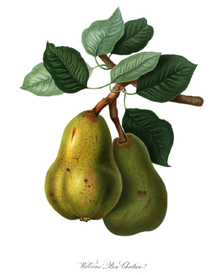Williams pear
| 'Williams' pear | |
|---|---|

The Williams pear. An 1822 print from the Horticultural Society of London
|
|
| Genus | Pyrus |
| Species | Pyrus communis |
| Cultivar | 'Williams' |
| Origin | Aldermaston, UK between 1765 and 1770 |
The Williams' bon chrétien pear, commonly called the Williams pear or the Bartlett pear in the United States and Canada, is the most commonly grown variety of pear in most countries outside Asia.
It is a cultivar (cultivated variety) of the species Pyrus communis, commonly known as the European Pear. The fruit has a bell shape, considered the traditional pear shape in the west, and its green skin turns yellow upon later ripening, although red-skinned derivative varieties exist. It is considered a summer pear, not as tolerant of cold as some varieties. It is often eaten raw, but holds its shape well when baked, and is a common choice for canned or other processed pear uses.
The origins of this variety are uncertain. "Bon Chrétien" (Good Christian) is named after Francis of Paola, a holy man whom King Louis XI of France had called to his deathbed as a healer in 1483. Francis offered the king a pear seed from his native Calabria with instructions to plant and care. Hence the pear tree was called "Good Christian". The Williams pear is thought to date from 1765 to 1770 from the yard of an Aldermaston, England, schoolmaster named Mr. Stair or Mr. Wheeler, giving rise to the now-obscure synonyms 'Aldermaston' pear and 'Stairs' pear. A nurseryman named Williams later acquired the variety, and after introducing it to the rest of England, the pear became known as the Williams Pear. However, the pear's full name is Williams' Bon Chretien, or "Williams' good Christian."
In 1799 James Carter imported several Williams trees into the United States, and they were planted on the grounds of Thomas Brewer in Roxbury, Massachusetts. The Massachusetts estate was later acquired by Enoch Bartlett of Dorchester, Massachusetts. Unaware of their origin, Bartlett named the pears after himself and introduced the variety into the United States. It was not realised that Bartlett and Williams Pears were the same until 1828, when new trees arrived from Europe. By that time the Bartlett variety had become vastly popular in the United States, and they are still generally known as Bartlett pears in the US and Canada, although there are about 150 other synonyms worldwide.
...
Wikipedia
